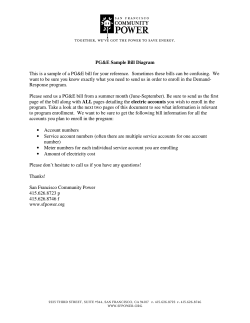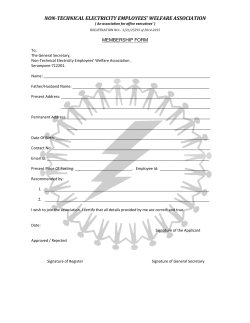
Science_1st and 2nd Class_Exploring Materials which will protect
Explorers Education Programme Date Class level First Class and Second Class Subject Science Strand Strand Unit Energy and Forces Magnetism and Electricity Title Exploring Materials which will protect Scuba Steve from Electric Fish Objective(s) The aim of the lesson plan is for children to identify materials that allow electricity to pass through them. Experiments and demonstrations are to be conducted by the teacher. Students will become aware of the dangers of electricity as well as learn about animals in the ocean that conduct electricity. Skills Required Observing, Investigating and Experimenting. Learning objectives Learning activities The child will be enabled to: Talk and Discussion: Discuss electricity with the children. Do Identify sea creatures which are capable the children know the uses of electricity? of producing electricity. In our houses, where does the electricity come from? Elicit from the children Observe the teacher as they create a vocabulary such as plugs and batteries. simple circuit. How does the electricity travel from the plugs or batteries to the item which we Experiment with materials to see which would like to be powered? allow electricity to pass through them and which do not. Explain to the children that it travels through the wires in a current. It may be Observe as the teacher tests slightly useful to have a lamp or similar item to damp materials to see if they allow a demonstrate this. The electricity travels current to pass through them. around the wires which we see all around the country. Identify materials suitable for a dry suit for swimming with creatures that Electricity is produced when energy is produce electricity. released from certain materials such as the burning of gas or coal. It can also be harnessed from nature. Elicit terms such as solar power, hydro power, wind power and wave power from the class. Does the class know that there are some fish which are capable of producing electricity? Show the class pictures of electric eels, electric rays and elephant www.explorers.ie Explorers Education Programme nose fish if internet access is available in the classroom. Discuss with the class how these animals have special organs capable of generating electricity. All muscle cells have electrical potential, however in this small group of fish, the animal has evolved special cells called electrocytes, which generate much higher voltages than ordinary muscle cells do. Explain to the students how they are going to investigate what materials would be best for a dry suit for Scuba Steve to be worn while swimming with these animals. Can we explore what materials do not let electricity pass through them, e.g. materials that are non-conductive. Teacher Directed Approach: Pupils observe the teacher creating a simple circuit using a bulb in a bulb holder, two wires and two batteries in a battery holder. The teacher clearly explains to the children how the current is flowing or moving through the wires from the batteries to the bulb and back to the batteries again (like a runner doing a full circuit of a race track) making the bulb light up. If the loop or circuit is broken than the bulb will not light up. The electricity will only flow through materials that are conductive, allow electricity to pass through them. Safety Notice: It is very important to explain to your students that this investigation or any other is never carried out using the electricity at the sockets in their home. Explain that the current from their battery packs is approx 3 Volts. The voltage from the standard household socket is between 220-240 volts. It is extremely dangerous and could cause death. Explain how they should never play with the plug sockets in their home. www.explorers.ie Explorers Education Programme Talk and Discussion: Explain to the children that you have a friend, Scuba Steve who loves to go diving and that they have a dream to go diving with some electric sea creatures. They are very worried that they might get a shock. They need to help of the class to create a dry suit which will keep them protected from the electrical shock. Divide the class into small groups. Each group is provided with a circuit already constructed. Explain to the groups how they will explore the materials provided and classify them into groups based on their ability to allow electricity to pass through or not allow electricity to pass through (conductive/ non-conductive). Free exploration of materials: Provide the groups with squares of a variety of materials. Use squares which are the same size if possible to ensure a fair test. Demonstrate for the class how to place a square of the material in the circuit. If the bulb lights, the material allows electricity to pass through it and is not suitable and if the bulb does not light, the material does not allow electricity to pass through and is suitable. Give the groups time to test and classify all their materials. Teacher Directed Approach: The teacher may demonstrate with some damp materials if moisture effects the investigation (after all the diver in the story will be in water when they are wearing the dry suit). To do this place the materials that were non-conductive (did not allow electricity to pass through) in a small amount of water for one minute. Remove from water before testing in the circuit as before. Did the dampness of the material affect the outcome? www.explorers.ie Explorers Education Programme It is not recommended that the pupils try this experiment themselves. It is vital that the teacher explains to the children the dangers of electricity and warns the children not to experiment with electricity while unsupervised and to never place water near electrical sockets. Collaborative Learning: The pupils design their dry suit in their groups. They can either draw it or create it from fabric and fibre. Resources - Lamp Pictures of electrical sea creatures. Good animal names to use during internet searches include: Electric Eel; Electric Ray; Elephant nose fish One circuit comprising of the following items for each group. - One battery holder containing two AA batteries. Three wires (ones with clip connections work best). Bulbs and bulb holders. Squares of a variety of materials – cardboard, plastic, cotton, tissue, wool, tinfoil, etc. One set per group. Water and tray for teacher demonstration. Template of a Scuba Steve (attached). Differentiation Higher and Lower Order Questions. Mixed Ability Grouping Assessment Teacher Observation and Questioning. Linkage and Integration Art: Creation of the dry suit in fabric and fibre. Oral language: Talk and discussion about their dry suit. www.explorers.ie Explorers Education Programme Scuba Steve www.explorers.ie
© Copyright 2025









